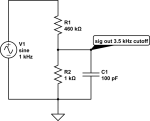Regarding MOSFET optocoupler relays like the Panasonic AQW212, am I correct in understanding that the capcitance between the terminals and ground when the switch is open ("off") is around 100pF when the potential across the terminals is small?
If you look at the datasheet for AQW212(http://www.kynix.com/uploadfiles/pdf8827/AQW212.pdf) it says it has low Coff but if you look at the chart that seems to not be the case. With a small voltage the capacitance rises sharply.
Consider the following example where the audio signal may be routed through a SS relay driven stepped potential divider like a volume control in the nearly off position:
I've been searching for a good pro-audio signal routing method that could work with somewhat arbitrary circuits like old mic preamps running on 24V or maybe even guitar tube amps that might switch 70V signals.

In this example, it so happens the circuit calls for a large resistance so as not to load the collector of a transistor amplifier perhaps. This arrangement conspires to produce high series resistance and low signal level which when coupled with the multiple drain / source capacitances of each device could result in high frequency loss.
Is this understanding correct? Or could a MOSFET based device be used to build something like a stepped attenuator?
I have also looked at devices like the Analog Devices iCMOS analog switches but these too have high junction capacitance. It seems the lower the on resistance, the higher the capacitance.
If only there were a mechanical relay with many positions like an old telephone exchange stepper switch but the size of a regular relay. Meaning a SP12T relay that can ratchet in either direction.
If you look at the datasheet for AQW212(http://www.kynix.com/uploadfiles/pdf8827/AQW212.pdf) it says it has low Coff but if you look at the chart that seems to not be the case. With a small voltage the capacitance rises sharply.
Consider the following example where the audio signal may be routed through a SS relay driven stepped potential divider like a volume control in the nearly off position:
I've been searching for a good pro-audio signal routing method that could work with somewhat arbitrary circuits like old mic preamps running on 24V or maybe even guitar tube amps that might switch 70V signals.

In this example, it so happens the circuit calls for a large resistance so as not to load the collector of a transistor amplifier perhaps. This arrangement conspires to produce high series resistance and low signal level which when coupled with the multiple drain / source capacitances of each device could result in high frequency loss.
Is this understanding correct? Or could a MOSFET based device be used to build something like a stepped attenuator?
I have also looked at devices like the Analog Devices iCMOS analog switches but these too have high junction capacitance. It seems the lower the on resistance, the higher the capacitance.
If only there were a mechanical relay with many positions like an old telephone exchange stepper switch but the size of a regular relay. Meaning a SP12T relay that can ratchet in either direction.
